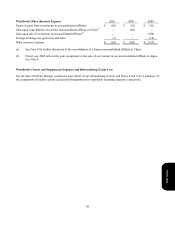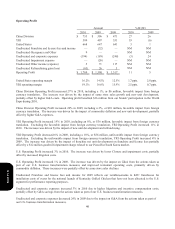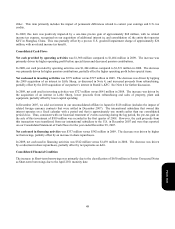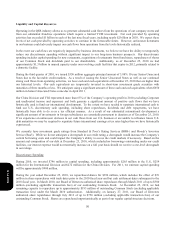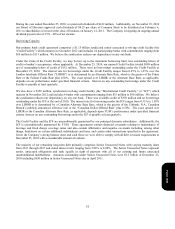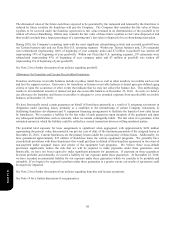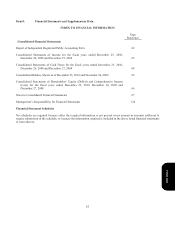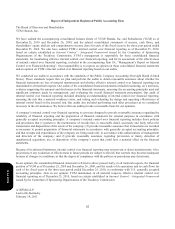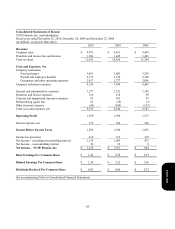Pizza Hut 2010 Annual Report Download - page 152
Download and view the complete annual report
Please find page 152 of the 2010 Pizza Hut annual report below. You can navigate through the pages in the report by either clicking on the pages listed below, or by using the keyword search tool below to find specific information within the annual report.
55
Impairment of Goodwill
We evaluate goodwill for impairment on an annual basis or more often if an event occurs or circumstances change that
indicates impairment might exist. Goodwill is evaluated for impairment through the comparison of fair value of our
reporting units to their carrying values. Our reporting units are our operating segments in the U.S., our YRI business units
(typically individual countries) and our China Division brands. Fair value is the price a willing buyer would pay for the
reporting unit, and is generally estimated using discounted expected future after-tax cash flows from company operations
and franchise royalties.
Future cash flow estimates and the discount rate are the key assumptions when estimating the fair value of a reporting
unit. Future cash flows are based on growth expectations relative to recent historical performance and incorporate sales
growth and margin improvement assumptions that we believe a buyer would assume when determining a purchase price
for the reporting unit. The sales growth and margin improvement assumptions that factor into the discounted cash flows
are highly correlated as cash flow growth can be achieved through various interrelated strategies such as product pricing
and restaurant productivity initiatives. The discount rate is our estimate of the required rate of return that a third-party
buyer would expect to receive when purchasing a business from us that constitutes a reporting unit. We believe the
discount rate is commensurate with the risks and uncertainty inherent in the forecasted cash flows.
The fair values of each of our reporting units were substantially in excess of their respective carrying values as of the 2010
goodwill impairment test that was performed at the beginning of the fourth quarter. However, our Pizza Hut United
Kingdom (“U.K.”) reporting unit, for which $104 million in goodwill was recorded at year end 2010, has experienced
deteriorating operating performance over the past several years as sales and profits have declined. Our forecasts of future
cash flows in determining the fair value of this reporting unit incorporate plans that have been put into place to return the
business to previous levels of profitability. These plans include specific measures to drive system sales growth, which is
the assumption that most significantly drives the cash flow expectations and resulting fair value estimations of the
reporting unit, over the next three years. While such forecasted system sales growth is higher than what we would
normally anticipate for a mature market like Pizza Hut U.K., such growth is reflective of our belief that the business has
experienced a temporary downturn and that sales declines in recent years can be recovered. If our plans to drive system
sales growth are not achieved or are not expected to be achieved, this could impact future estimations of fair value of the
Pizza Hut U.K. reporting unit and result in impairment of some or all of the Pizza Hut U.K. recorded goodwill. Likewise,
if other events, such as higher than anticipated inflation that we were unable to recover through increased sales, were to
occur that would negatively impact the outlook for the business and our resulting estimations of fair value, some or all of
the goodwill could be impaired.
When we refranchise restaurants we include goodwill in the carrying amount of the restaurants disposed of based on the
relative fair values of the portion of the reporting unit disposed of in the refranchising and the portion of the reporting unit
that will be retained. The fair value of the portion of the reporting unit disposed of in a refranchising is determined by
reference to the discounted value of the future cash flows expected to be generated by the restaurant and retained by the
franchisee, which include a deduction for the anticipated, future royalties the franchisee will pay us associated with the
franchise agreement entered into simultaneously with the refranchising transaction. Appropriate adjustments are made if
such franchise agreement is determined to not be at prevailing market rates. When determining whether such franchise
agreement is at prevailing market rates our primary consideration is consistency with the terms of our current franchise
agreements both within the country that the restaurants are being refranchised in and around the world. The Company
believes consistency in royalty rates as a percentage of sales is appropriate as the Company and franchisee share in the
impact of near-term fluctuations in sales results with the acknowledgment that over the long-term the royalty rate
represents an appropriate rate for both parties.
Form 10-K


